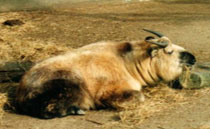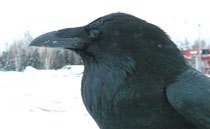Bhutan - Wildlife Sanctuaries


Jigme Dorji National Park
Jigme Dorji National Park is the largest protected area in the country, encompassing an area of 4329 sq km. It protects the western parts of Paro, thimphu and Punakha districts and almost entire area of Gasa district.
Fauna:- The Park is the habitat of several endangered species, including the takin, snow leopard, blue sheep, tiger, musk deer, red panda, himalayan black bear and serow. Other mammals to be found are leopard, wild dog, sambar, barking deer, goral, marmot and pika. More than 300 species of birds have been catalogued within the park.
Flora:- The park also has equally rich floral species consisting of a unique caterpillar fungus Cordyceps sinensis, rhododendrons, chirpines, cypress and hundreds of alpine medicinal and aromatic plants. It is also the only park in Bhutan where national animal (takin), flower (blue poppy), bird (raven) and tree (cypress) exist together.
Royal Manas National Park
Located in the south central part of Bhutan, Royal Manas National Park has an area of 1023 sq km. It is the oldest protected area system in Bhutan, established as early as 1966 and upgraded as national park in 1993.
The park covers three districts of Zhemgang, Sarpang and Samdrup Jongkhar.
Fauna:- It is the home of rhinos, buffalos, tigers, leopard, gaurs, bears, elephants and several species of deer. Also, several rare species are found here including the golden langur, capped langur, pygmy hog and hispid hare. Others such as wild boars, wild dog, barking deer, pygmy hog, hornbill and peacock are not a surprise. The bird species is extremely rich with a record of over 362 species.
Black Mountains National Park
The 1400-sq-km Black Mountain National Park protects the range of hills that separates eastern and western Bhutan. It is an important area because it includes virgin forests in an area that is generally known as the middle hills.
Flora:- Plant life in park includes a wide range of broadleaf species, conifers and alpine pastures.
Fauna:- Animals include tigers, Himalayan black bears, leopards, red pandas, gorals, serows, sambars, wild pigs, golden langurs and amazing 449 species of birds have been catalogued.
Phibsoo Wildlife Sanctuary
Phibsoo Wildlife Sanctuary located in the South-central Bhutan. The Sanctuary has an area of 278 Sq. Km and falls under Sarpang Dzongkhag. It is the only protected areas in the country where natural Sal forest are found.
Fauna:- Several protected species thrive in this sanctuary, including axis deer, chital, elephant, gaur, tiger, golden langur and hornbill.
Thrumshing La National Park
The 768 sq km Thrumshing la National Park lies between Bumthang and Mongar and protects temperate forests of fir and chir pine. It is known for its scenic vies, dense forests and alpine meadows.
Fauna:- Presence of threatened species viz. rufous necked hornbill, Satyra tragopan, Ward’s trogon, chestnut breasted partridge is a noteworthy feature of this reserve.
Bomdeling Wildlife Sanctuary
Bumdeling Wildlife Sanctuary (BWS) is located in the northeastern part of Bhutan and covers an area of 1538 sq. km encompassing parts of Trashi Yangtse, Lhuentse, and Mongar districts.
Fauna:- This sanctuary protects the habitat of blue sheep, snow leopard, red panda, tiger, leopard, Himalayan black bear, musk deer, wild boar, wild dog and fox. The sanctuary is a show case for 293 species of birds. There are also 32 species of butterflies out of which some are identified as rare. Bomdeling Wildlife Sanctuary is also one of the two winter habitats for the black-necked cranes, which come down from the Tibetan plateau to escape the extreme weather conditions.
Sakteng Wildlife Sanctuary
Located in the Eastern Part of Bhutan, Sakteng Wildlife Sanctuary with an area of 650 Sq. Km is one of the new protected areas to be recently operationalised in the year 2002. The two geogs of Merak and Sakteng under Trashigang Dzongkhag falls under this Sanctuary. It was specially created to protect the habitat of the yeti.
Flora:- Sakteng Wildlife Sanctuary protects the easternmost temperate forest ecosystems in the country with endemic species like eastern blue pine, black-rumped magpie and many others found only in the east.
Khaling Wildlife Sanctuary
Khaling Wildife Sanctuary is located in the south-eastern part of Bhutan with an area of 273 Sq. Km. The Sanctuary covers only one Dzongkhag of Sandrup Jongkhar. It is the smallest of Bhutan's protected areas with an altitude range of 400-2,200 meters
Fauna:- This wildlife sanctuary is important for elephant (Elephas maximus), gaur and other tropical wildlife and may also contain the rare pygmy hog and hispid hare .
Torsa Strict Nature Reserve
It is in the western part of the Haa District (644 sq. km) protects the westernmost temperate forests of the country, from broadleaf forests to alpine meadows within an altitude range of 1,400-4,800m, and includes the small lakes of Sinchulungpa. Unlike Bhutan's other protected areas, Torsa has no resident human population.





